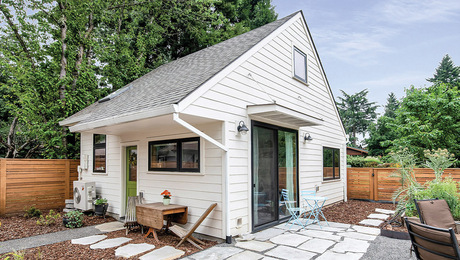Small-Job Concrete
Site-mixed mud can be batched as accurately as ready-mix, given a strong back and a few guidelines.

Synopsis: A short but useful guide to mixing your own concrete. Charts provide the correct proportions of cement, aggregate, and water.
Most batch plants charge extra for less than a cubic yard or two of concrete. The service you’re likely to get on a small order is pretty minimal, so it often makes sense to mix on site. You can do this by hand in a trough or wheelbarrow, or you can rent a mechanical concrete mixer. You’ll be using the same ingredients as the batch plant; if you measure and mix carefully, the quality of the concrete should be at least as good. For folks beyond the range of ready-mix trucks, this is the only way.
Ingredients
Clean water is a must for concrete. Sea water is okay if the concrete won’t be reinforced with steel. The pour will attain high early strength, but will not be as strong in the long run. Increase the cement content and reduce the water to recover some of the strength lost to the salt.
Cement should be bought by the 94-lb. bag and kept dry. In most cases, Type I is what you need. For resistance to freeze-thaw cycles in northern climates, buy air-entrained cement, which requires using a portable power mixer, since the air-entraining agent needs vigorous mechanical agitation to be effective.
Large aggregate and sand can be purchased by the cubic yard from quarries, building-supply yards and batch plants. Large aggregate can range from ½ in. to 1½ in. It should be clean, hard, durable gravel or crushed stone such as granite or hard limestone. Most sandstone isn’t usable. Crushed stone should be square, triangular or rectangular in shape, Flat, elongated pieces shouldn’t be used, Sand, the fine aggregate, should be a mix of coarse and fine grains up to ¼ in.
When ordering cement and aggregates, keep in mind that the amount of concrete you get from mixing the ingredients is not nearly as much as the sum of the volume of those materials. This is because the sand in the mix fills in the voids between the gravel or stone, and the cement nestles in between the particles of sand. A rule of thumb that’s sometimes used is to figure the amount of your mix to be slightly greater than the amount of coarse aggregate you’re using. The chart below will get you a little closer, so you don’t end up short on the last batch of your pour.
Unless you are pouring just a few cubic feet of concrete, which can be done using dry-packaged pre-mix, have the aggregates and cement delivered. These materials are extremely heavy, and your good old pickup truck can easily get overloaded with a half-yard of wet sand. Most suppliers will deliver with a dump truck that can spot the materials almost anyplace. As near as possible to where you’ll be mixing and pouring is best. Lay plastic sheeting, 6 mil or heavier, on the ground for each kind of aggregate. Plywood is even better because it is a harder surface for scooping against with a shovel, but don’t plan on using the plywood for anything very important afterward. You can also use old plywood to separate the sand and coarse aggregate piles vertically, so that they can be placed close together without mingling. Stack bags of cement close together, and up off the ground so they don’t turn to stone. Cover them with waterproof plastic whether or not it looks like rain. Don’t use cement that is so hard it won’t crumble in your hand.
For more photos and details, click the View PDF button below:


























